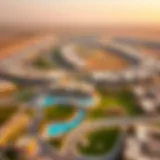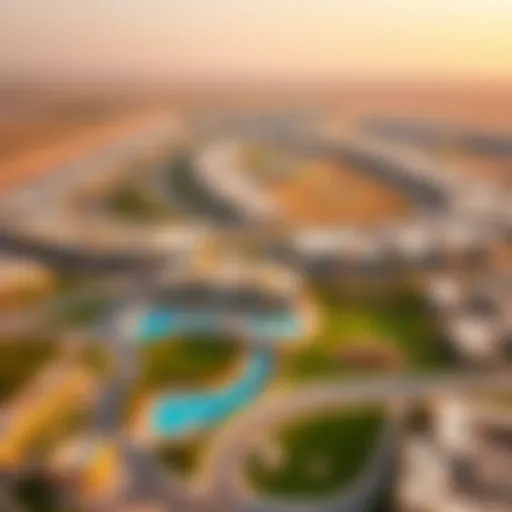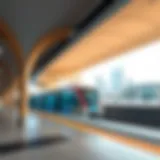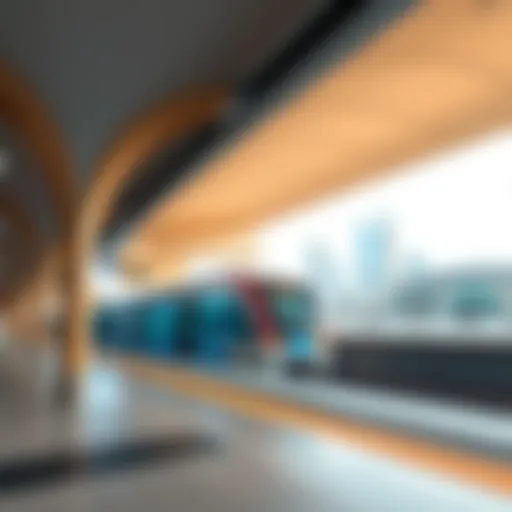Exploring the Festival Office Tower Concept in Dubai
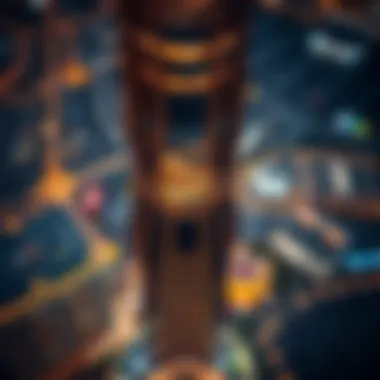

Intro
In recent years, there has been a noticeable shift in architectural designs, particularly in urban areas like Dubai. More than mere structures, developers are increasingly considering the cultural dynamics of the regions where they build. This new mindset has birthed the idea of the Festival Office Tower, which not only serves as a space for commercial activities but also harmonizes with cultural events and community life. This exploration delves into the motivations behind such an architectural concept, examining how these innovative towers can transform cityscapes and elevate the urban experience for both residents and visitors.
The Festival Office Tower aims to integrate various facets of urban life, celebrating both functionality and vibrancy. By analyzing this concept, we can begin to understand its implications for community engagement and economic dynamics in a rapidly evolving city like Dubai.
Market Trends
Current Market Analysis
Dubai's real estate market presents an interesting scenario for the Festival Office Tower concept. Major commercial hubs are witnessing an influx of investors and businesses looking for unique spaces that foster creativity and social interaction. The blending of work and play is clearly visible in many upcoming projects where commercial spaces are designed with leisure elements in mind. The demand for spaces that promote convenience, aesthetics, and cultural activity is driving architects and developers alike to reimagine conventional office designs.
The urban landscape is no longer strictly defined by traditional office buildings. Instead, spaces like the Festival Office Tower are increasingly being seen as essential components of the city’s economic fabric. Studies suggest that buildings which dedicate portions of their design to cultural activities can lead to higher tenant retention and increased foot traffic.
Future Projections
As we forecast into the next decade, the Festival Office Tower model seems poised for expansion. Like a well-planned symphony, it orchestrates commercial success with cultural engagement, a duality that speaks to the future needs of cities.
- The following factors may influence potential growth:
- Cultural Trends: As societies move towards more inclusive and diverse experiences, the Festival Office Tower may serve as a benchmark for blending community and commerce.
- Sustainability Initiatives: Environmental focus is growing; thus, integrating green technology and sustainable materials into these towers may enhance their appeal significantly.
- Urban Development Policies: Governments supporting cultural initiatives may lead to an increase in funding and incentives for such projects.
Analysts predict that by 2030, a significant portion of new office developments will not just serve business needs but will also function as cultural hubs, with the Festival Office Tower being a leader in this transformation.
Property Insights
Neighborhood Comparisons
Understanding the context of neighborhoods surrounding the Festival Office Tower can provide a deeper insight into its potential success. Areas rich in cultural heritage typically attract artists, creators, and businesses alike. For instance, Dubai’s Al Seef district, which blends traditional architecture with modern amenities, could serve as a prime location for such a tower. Other neighborhoods, such as Downtown Dubai and the Dubai Design District, also present unique opportunities for the Festival Office Tower concept due to their existing infrastructure, lively community interactions, and business ecosystems.
Property Types Explained
The Festival Office Tower encompasses more than just traditional office space. Its design may include:
- Co-working Spaces: Areas promoting collaboration, equipped with modern facilities.
- Event Venues: Spaces designed for festivals, exhibitions, and social gatherings that bring the community together.
- Retail Spaces: Shops and cafes that enhance the visitor experience while supporting local businesses.
- Leisure Facilities: Parks or recreational areas that foster relaxation and cultural appreciation.
This blend of property types is what makes the Festival Office Tower an intriguing case study for future urban designs. The versatility of the tower can serve various audience segments, turning it into a hotspot for economic and cultural activity.
"The future of urban architecture lies in creating spaces that not just accommodate, but actively engage and inspire the communities around them."
Ultimately, the Festival Office Tower is not just about bricks and mortar; it’s about designing a space that resonates with the heart of the city and the people within it. As we continue to explore this topic, it becomes clear that the intersection of festivals and architecture reflects a broader societal shift towards cultural integration within urban environments.
Prolusion to the Festival Office Tower
The concept of the Festival Office Tower stands at an intriguing crossroads of commercial utility and cultural celebration. In urban landscapes like Dubai, where the skyline constantly evolves, this blend of purpose and festivity takes on heightened significance. It’s not just about erecting structures; it’s about creating spaces that resonate with the spirit of the community and reflect the dynamism of city life.
One must consider what shapes these towers—design, functionality, and social impact are just three threads weaving into this complex tapestry. Imagine a high-rise that serves as more than just an office; picture spaces buzzing with events, festivals, and exchanges of ideas. Every aspect of the Festival Office Tower is carefully curated to enhance urban existence. The idea encapsulates how architecture can foster connections, allowing commerce and culture to coexist and thrive.
As we delve into this narrative, we will explore various elements of the Festival Office Tower, from its defining features to historical influences shaping its existence. The importance of this discussion lies in its implications for stakeholders such as investors, homebuyers, and urban planners who seek not only to profit but to contribute positively to the urban fabric.
Defining the Festival Office Tower Concept
To grasp the essence of the Festival Office Tower, one must first dissect the concept itself. Fundamentally, this architecture doesn't just house businesses; it creates a hub for interaction, creativity, and culture. At the core, it combines traditional office functionalities with areas designated for cultural events, exhibitions, and communal activities. This dual-purpose structure helps to foster a lifestyle that values both work and community engagement.
While a typical office tower might be characterized by sterile working conditions, a Festival Office Tower injects vibrancy into these spaces.
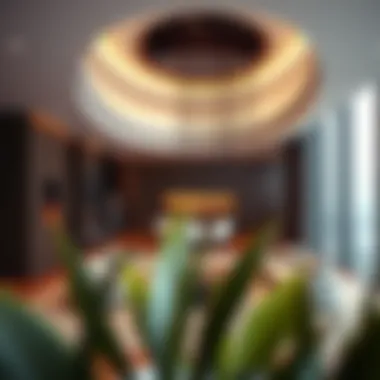

- Cultural Activities: Spaces for seasonal festivals, art displays, and local performances.
- Collaborative Work Areas: Large communal spaces that encourage cross-domain innovation.
- Dining and Leisure Facilities: Restaurants and relaxation spots providing social and culinary experiences for visitors and workers alike.
As a result, these structures promote a bustling atmosphere, making everyday work feel a little more like community bonding.
Historical Context and Evolution
Understanding the Festival Office Tower requires looking back at the evolution of mixed-use developments. The fusion of work and leisure is not a novel endeavor; however, its execution in modern architecture can be traced to the changing tides in urban planning.
Historically, city construction focused heavily on segregated zones—residential here, commercial there. However, with increased urbanization, a realization emerged: people thrive in environments where aspects of their lives intertwine. Thus, the inception of mixed-use developments brought forth not just a shift in design but also a cultural renaissance. Cities began embracing projects that allowed buildings to serve multiple purposes instead of standing as solitary structures.
Dubai stands as a prime example, where rapid growth has necessitated such innovative approaches. The Festival Office Tower concept draws from this historical evolution, merging workspace and communal spaces to cater to an increasingly diverse urban population.
In summary, by looking back, one can appreciate how the Festival Office Tower beautifully marries the building’s purpose to the prevailing winds of urban culture.
Architectural Design and Features
The Architectural Design and Features of the Festival Office Tower play a pivotal role in its function and appeal. As urban centers clash with cultural aspirations, these designs breathe life into concrete, offering spaces that foster creativity, collaboration, and community engagement. The intersection of architecture and festival-based activities creates a unique symbiotic relationship that transforms the skyline while presenting opportunities for enhanced urban experiences. To truly grasp its impact, it's essential to dissect the crucial elements that define this concept.
Key Design Principles
When it comes to the Festival Office Tower, certain design principles take center stage. These are not just guidelines; they are the backbone that ensures functionality and allure.
- Flexibility: The tower must cater to various events, from exhibitions to trade fairs. Open floor plans and movable partitions enable diverse configurations based on specific needs.
- Inclusivity: Aimed at uniting various facets of the community, designs ought to reflect local culture while being welcoming to all demographics.
- Connectivity: Integration with public transport and pedestrian pathways ensures that the tower is not an isolated structure but a thriving hub within the urban fabric.
- Aesthetic Appeal: An eye-catching facade, perhaps utilizing local materials, can make the building a landmark, embodying both tradition and modernity.
Each principle enhances the user experience, ensuring that the Festival Office Tower is not merely a place of work but a vibrant environment conducive to creativity and civic pride.
Integration of Public Spaces
The spaces that invite the public into the Festival Office Tower are its lifeblood. Integrating public spaces within and around the tower encourages a melding of diverse activities. This can manifest in several impactful ways:
- Plazas and Green Areas: Utilizing the land around the tower for open plazas or gardens offers spaces for festivals, pop-up markets, or just a place to unwind.
- Exhibition Halls: These should be adaptable spaces where art can breathe and local talent can showcase their work, further embedding the cultural narrative of the area.
- Cafes and Restaurants: Incorporating dining options allows the building to function as a social hub, inviting city dwellers to enjoy their meals in a dynamic environment.
By ensuring that these public spaces are easily accessible, the Festival Office Tower can serve as a confluence of cultures, fostering interactions that might not occur in isolated settings.
Sustainability Considerations
Sustainability in architectural design has transformed from a trend into an expectation. The Festival Office Tower must embody this ethos; it's not just about looking good, but it's about leaving a minimal environmental footprint. Several sustainability considerations can be implemented:
- Green Roofs and Vertical Gardens: These not only enhance aesthetics but also improve air quality and provide insulation.
- Energy Efficiency: Incorporation of renewable energy sources such as solar panels can significantly reduce dependence on non-renewable energy. The use of energy-efficient lighting and HVAC systems also contributes to lower operational costs.
- Water Management: Implementing rainwater harvesting systems can help manage water usage and alleviate strain during drought conditions.
In harnessing these sustainability practices, the Festival Office Tower might become a model for future developments, demonstrating that aesthetic, functionality, and environmental responsibility can harmoniously coexist.
"Sustainability should not just be an add-on; it's crucial to leave a better place for future generations."
By centering the architectural design around these core principles—flexibility, inclusivity, connectivity, aesthetic appeal, public integration, and sustainability—the Festival Office Tower stands as a beacon in modern architecture. Its design is not just about meeting today's demands but about bracing for tomorrow's possibilities.
Cultural Significance
The Festival Office Tower concept carries profound cultural significance in contemporary urban landscapes, particularly in cities like Dubai where modernity and tradition intersect. Architectural structures, especially those designed with a festival framework in mind, serve not only functional purposes but also act as cultural beacons. They provide a platform for expression, creativity, and community engagement, inviting residents and tourists alike to partake in shared experiences. This multi-layered role transforms the perception of real estate into a celebration of local narratives and artistic endeavors.
Promotion of Local Art and Culture
Local art and culture thrive within the confines of Festival Office Towers, offering an incubator for creative minds. By integrating galleries, performance spaces, and venues for local artisans, these towers elevate the status of local identity within the architectural dialogue. For example, the use of art installations that depict regional stories fosters a connection between the building and the community. Visitors may find murals that narrate the history of the area or sculptures representing cultural motifs.
This architecture encourages collaboration between artists and entrepreneurs, leading to events such as art fairs or cultural festivals hosted right within the tower. These gatherings not only enhance visibility for local talent but also attract individuals who otherwise may not engage with the arts.
Moreover, the incorporation of traditional artistic elements into modern designs showcases an innovative blend that respects the past while engaging with the future. Such visual dialogues ensure that culture remains vital, adaptive, and relevant, enhancing the building's significance as a cultural hub.
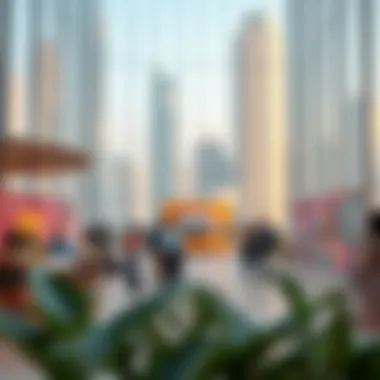

Role in Community Engagement
Community engagement is central to the success of any Festival Office Tower. These structures promote a sense of ownership among residents, encouraging participation in decision-making processes related to events and initiatives in the space.
Creating open access to public areas within the tower allows for spontaneous gatherings and cultural dialogues, transforming how individuals interact with business and social environments. The spaces designed for community use—be it a rooftop garden or a shared exhibition area—function as catalysts for social interaction.
Local businesses benefit, as they often provide services for events hosted in these spaces, thereby reinforcing economic ties within the community. Initiatives such as workshops, community fairs, or cultural education programs can dynamically engage diverse demographics, from young families to retirees. Throughout these activities, residents nurture relationships with one another, breaking barriers that often segregate urban life.
“The strongest communities are built around shared experiences and collective memories.”
Economic Implications
The economic implications of Festival Office Towers serve as a critical component in understanding their role within urban landscapes. These structures represent more than just architectural feats; they embody a fusion of commercial, cultural, and social elements that contribute to a city's economic vitality. By integrating office space with festival activities, these towers spark interactions and attract investment, greatly impacting local economies.
Attracting Investment
Investment plays a pivotal role in the development of Festival Office Towers. Developers and investors are increasingly drawn to projects that promise not just financial returns but also community engagement and cultural significance. The unique blend of office space and festival-related amenities makes these projects appealing as they can diversify income streams. Investors often look for mixed-use developments in urban centers that attract foot traffic.
Significant financial opportunities arise when incentivizing private-public partnerships. When local governments support these projects, they provide an environment where investments can flourish. As a result, the economic landscape can shift positively, resulting in increased property values and business activity. For example, in the heart of Dubai, a recent Festival Office Tower prompted multiple multinational corporations to set up offices nearby. This influx of businesses led to a ripple effect, as ancillary services like cafes, restaurants, and retail shops began to open up, further enhancing the area’s appeal.
Impact on Local Businesses
The establishment of a Festival Office Tower catalyzes positive changes in local businesses. The influx of visitors and professionals creates a higher demand for goods and services. Many local businesses report increased footfall as city dwellers and tourists flock to these areas for both work and play. Here are a few ways businesses can benefit:
- Increased visibility: When a local business is situated near a hub of activity, more individuals are likely to notice and patronize them.
- Collaboration opportunities: Local businesses can leverage events hosted within the Festival Office Tower to collaborate on promotions or offerings.
- Networking potential: Business owners have the chance to connect with others in similar sectors, leading to potential partnerships or innovative ideas.
However, it’s crucial to recognize challenges too. Not all local businesses may thrive in such competitive environments. Some may struggle against larger chain competitors drawn to the increased foot traffic, which might divert customers away from smaller, family-owned enterprises.
Tourism Opportunities and Challenges
Tourism is often at the forefront when considering the economic implications of Festival Office Towers. These structures not only enhance the skyline but also serve as attractions in their own right. They create venues for various cultural events—art exhibitions, concerts, and food festivals—that draw tourists from all over the globe.
The potential for tourism revenue cannot be overstated. As people travel to experience local culture, they contribute significantly to the economy. Hotels, transportation services, and local attractions will see a boost in patronage, fostering economic growth throughout the city.
Yet, the rise in tourism also presents challenges. Overcrowding, especially during peak events, can lead to frustration among locals. Maintaining a balance between enjoying the vibrancy that tourism brings and safeguarding the quality of life for residents becomes essential. Without thoughtful management, tourism can detract from the neighborhood's charm, transforming it into a mere spectacle rather than a thriving community.
Festival Office Tower in the Context of Dubai
The introduction of the Festival Office Tower in Dubai signifies a pivotal moment in how architectural developments can shape and enhance urban life. Dubai, known for its towering skyscrapers and avant-garde constructions, stands at the forefront of architectural innovation. This concept fits seamlessly into the landscape that balances commercial interests with vibrant cultural interactions. The notion isn't just about erecting a building; it’s about fostering a dynamic environment where business, art, and community converge.
Current Trends in Dubai’s Architecture
Dubai’s architectural scene has been embracing a fusion of styles and functionalities over recent years. Alongside traditional designs, there’s an increasing focus on mixed-use developments that blend residential, commercial, and cultural spaces. This evolution reflects a global trend where urban planners seek to create inclusive spaces catered to a variety of lifestyles. For instance, the likes of the Burj Khalifa and the Dubai Opera have already showcased how tall structures can integrate with cultural offerings.
- Functional Zoning: A Shift
The Festival Office Tower exemplifies this trend by harmonizing different uses within a single structure. Workspaces are combined with venues for art exhibits, performances, and community gatherings. This not only optimizes space but invigorates areas that might otherwise be limited by corporate designs. - Sustainable Practices:
Incorporating elements such as green roofs and energy-efficient materials is now more than just a bonus; it is a necessity. Buildings like the Festival Office Tower aim to reflect Dubai’s ambition towards sustainability, catering to environmentally conscious investors and residents alike.
Regulatory Environment for Mixed-Use Development
The regulatory framework surrounding mixed-use developments in Dubai is continually evolving, adapting to the demands of modernization while preserving the cultural essence of the region. Authorities play a crucial role in facilitating these projects, ensuring they align with both commercial viability and social impact.
- Zoning Laws:
Dubai’s zoning regulations have become more flexible for mixed-use projects, allowing developers to design spaces that are not only functional but also community-centric. This flexibility is vital in areas like Dubai Marina or Downtown Dubai, where a blend of residential and commercial spaces is encouraged. - Incentives for Innovation:
The government has introduced various incentives for projects that align with sustainability and cultural engagement. Subsidies or tax breaks can often be significant motivators for developers willing to invest in mixed-use towers, urging them to not just think about profit but also about impact and legacy.
In summary, the promotion of the Festival Office Tower in Dubai springs from a mix of current architectural trends and an adaptive regulatory environment. This intersection opens doors for innovative designs that not only enhance the skyline but also enrich the daily lives of the people who live and work there. As Dubai continues to grow, such concepts will remain pivotal in shaping a vibrant and sustainable urban future.
Challenges and Considerations
The integration of cultural celebrations within architectural endeavors, encapsulated in the Festival Office Tower concept, certainly comes with its share of challenges and considerations. Understanding these hurdles is essential to assessing how well such structures can actually blend the often contrasting worlds of commerce and culture. As cities evolve and become denser, the need for this harmonious balance has never been more pressing. A focused exploration of these challenges not only highlights the opportunities that exist but also sheds light on how to mitigate potential pitfalls.


Balancing Commercial and Cultural Needs
In the quest to create a vibrant urban environment, developers often face the daunting task of balancing commercial viability with cultural significance. On one hand, Festival Office Towers aim to attract businesses and investors, thus generating economic activity; on the other hand, they can serve as cultural hubs that celebrate local traditions and artistic expression.
The key here lies in striking the right balance. For instance, commercial spaces should be designed in a way that does not overshadow the cultural aspects. This can be achieved by incorporating design features that highlight local materials, architectural styles, and community sentiments, creating an inviting atmosphere. The challenge arises when the needs of investors and businesses demand particular configurations that might detract from the intended cultural vibrancy. Investment strategies, therefore, must consider how commercial zones can coexist without hijacking the identity of the festival spirit these towers aspire to embrace.
"Urban spaces should act as a canvas for cultural expression, but must also generate economic activity to sustain them."
To effectively achieve this balance, stakeholder engagement is crucial. Involving community members, artists, and local businesses in the planning stages can lead to designs that are both economically sustainable and culturally enriching. This synergy not only supports a deeper connection to the space but allows residents and visitors alike to feel involved in its narrative.
Urban Density and Infrastructure Strain
As cities like Dubai grow and architectural wonders like Festival Office Towers rise, the implications of urban density and infrastructure strain become increasingly significant. These towers, while magnificent in design, contribute to a growing concern about how well the existing infrastructure can support an influx of visitors and residents.
Increased density often strains public services including transportation, waste management, and utilities. As these towers become focal points for festivals and events with large crowds, the pressure on surrounding infrastructure intensifies. Improving public transport links becomes essential, as does ensuring that facilities such as restrooms, parking, and other amenities can handle sudden spikes in usage.
Proactive planning directed at mitigating these issues could include:
- Developing integrated transport networks that connect Festival Office Towers with major transit hubs.
- Designing multi-purpose spaces within the towers that can adapt for different uses, reducing the need for excessive external facilities.
- Implementing smart technology to monitor and manage crowd flow, aiding infrastructure efficiency.
A comprehensive approach recognizing that each solution must simultaneously address both commercial interests and the cultural fabric of society is vital. Moving forward, it will be increasingly important for urban planners and developers to collaborate closely, respecting the multifaceted nature of the environments in which these towers exist.
Future Outlook for Festival Office Towers
As cities evolve, the integration of commercial and cultural spaces becomes paramount. Festival Office Towers stand at the intersection of this evolution, reflecting urban needs while granting significant importance to culture. They're not just buildings; they symbolize a shift in how we perceive urban life. In this section, we will examine how these structures can redefine city spaces and what lies ahead.
Innovations in Design and Functionality
Innovative design is crucial for the success of Festival Office Towers. The architecture needs to be forward-thinking and adaptable, allowing for a synergy between business and local festivities. An example includes the incorporation of flexible space. Many new projects are looking at ways to have modifiable sections, able to accommodate both office use during the week and bustling art markets or festivals during weekends.
Moreover, green technology plays a vital role here. Utilizing smart materials, such as self-cleaning glass or energy-efficient lighting, not only enhances the aesthetic appeal but also promotes sustainability. Buildings like those featuring solar panels or vertical gardens make the structures stand out and emphasize the blend of nature within urban settings.
"The design of a Festival Office Tower must reflect a community’s spirit and be responsive to its dynamic cultural landscape."
Another design trend is the incorporation of public art. Collaborating with local artists can infuse a Festival Office Tower with unique visual narratives, enhancing both identity and community pride. Engaging with artists, architects, and the public can lead to designs that resonate with local heritage, making these spaces much more than mere workplaces.
Predictions for Urban Development Trends
Looking towards the future, it’s essential to anticipate changes in urban development that will influence the rise of Festival Office Towers. Firstly, as remote work becomes more normalized, there’s a potential shift in people’s expectations for office environments. Spaces that encourage collaboration and creativity will be in much higher demand. Expect more open-plan designs coupled with private areas, promoting interaction while catering to individual work styles.
Additionally, the rise of mixed-use developments will continue to gain traction, driven by an increasing desire for walkable neighborhoods. The blend of living, working, and leisure activities in close proximity aligns with modern lifestyle priorities. As a result, developers might pursue projects resembling the Festival Office Tower, showcasing a varied use of space that entices residents and businesses alike.
In essence, the future landscape of urban architecture holds promising changes. As developers and city planners recognize the value of adaptability and cultural integration, Festival Office Towers are likely to become a hallmark of progressive city development. Not only will they look good on paper, they will embody a city’s essence – fostering community, enhancing connectivity, and promoting a thriving economy.
Finale
In reflecting on the Festival Office Tower concept, the intertwining of architectural design with cultural festivities stands as a testament to evolving urban landscapes. This innovative model provides a rich tapestry of possibilities, effectively blending commercial opportunities with vibrant community engagement. The importance of this topic lies in its multifaceted nature—recognizing that the structures we create can serve not just as mere buildings, but as dynamic venues for social interaction and cultural expression.
Summary of Key Insights
The analysis throughout this article has underscored several pivotal insights into the Festival Office Tower's role within modern urban environments. Some key takeaways include:
- Cultural Integration: The incorporation of art and local culture within these towers not only promotes tourism but strengthens community identity.
- Sustainability: Architectural innovations within these developments often align with sustainability goals, providing green spaces and eco-friendly designs that resonate with today’s environmental consciousness.
- Economic Benefits: These towers attract investment and can significantly boost local business through increased foot traffic and tourism.
"The Festival Office Tower exemplifies how architecture can embrace culture and commerce, crafting spaces that nurture both business and community spirit."
Final Thoughts on the Role of Festival Office Towers in Urban Landscapes
As we gaze toward the horizon of urban architecture, the Festival Office Tower offers a glimpse into a thoughtful future. The design is not just about erecting a structure; it’s about fostering connections among people, businesses, and the surrounding environment. Investors and buyers alike should consider the cultural, social, and environmental returns that such developments promise.
The potential for enhanced urban vitality hinges on the successful implementation of these concepts, demonstrating that when architects and planners embrace festivity and connection, they pave the way for enriched urban experiences. In a city like Dubai, where innovation is key, the role of the Festival Office Tower may serve as a pioneering blueprint for urban centers worldwide.
Moving forward, continued investment in such creative architectural endeavors is essential for cultivating dynamic, interactive spaces that reflect the vibrant culture and history of their locales.




